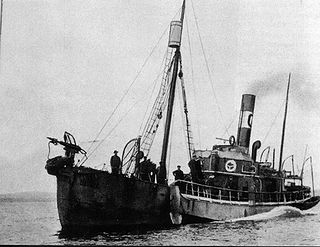
The Sea of Japan is the marginal sea between the Japanese archipelago, Sakhalin, the Korean Peninsula and Russia. The Japanese archipelago separates the sea from the Pacific Ocean. It is bordered by Japan, Korea and Russia. Like the Mediterranean Sea, it has almost no tides due to its nearly complete enclosure from the Pacific Ocean. This isolation also reflects in the fauna species and in the water salinity, which is lower than in the ocean. The sea has no large islands, bays or capes. Its water balance is mostly determined by the inflow and outflow through the straits connecting it to the neighboring seas and Pacific Ocean. Few rivers discharge into the sea and their total contribution to the water exchange is within 1%.

Shelikhov Gulf is a large gulf off the northwestern coast of Kamchatka, Russia. It is located in the northeastern corner of the Sea of Okhotsk and it branches into two main arms, Gizhigin Bay to the west and Penzhina Bay to the east. Its southwest corner is formed by the P'yagin Peninsula, Yam Gulf and the Yamsky Islands.

Penzhina Bay is a long and narrow bay off the northwestern coast of Kamchatka, Russia.
Sakhalin Gulf is a gulf in the Sea of Okhotsk between continental Russia and the northern tip of Sakhalin Island. The width of the gulf reaches up to 160 km. It is covered with ice from mid-November until late April, but north winds can leave the bay blocked with ice until July.

The Shantar Islands are a group of fifteen islands located off the northwestern shore of the Sea of Okhotsk east of Uda Gulf and north of Academy Bay. Most of the islands have rugged cliffs, but they are of moderate height; the highest point in the island group is 720 metres.

Bolshoy Shantar is an island in the Sea of Okhotsk, Russia. It is the main island of the Shantar Islands. Its area is 1766 km². It is about 72 km (44.7 mi) in length and 49 km (30.4 mi) in width. It has a large brackish lake on its north side which is connected to the sea through a narrow passage. Yakshin Bay indents the southwest side of the island.

Feklistova or Feklistov Island is one of the Shantar Islands in Sea of Okhotsk. With an area of 372 km², it is the second largest in the archipelago.

Zavyalov Island, formerly Ola Island, is a relatively large island in the Sea of Okhotsk, northwestern Pacific. It is located on the eastern side of Taui Bay, 20 km west of Cape Taran, Koni Peninsula, about 50 km south of the city of Magadan.

Iony Island, or Jonas' Island, formerly Ostrov Svyatogo Iony, is a small island in the Sea of Okhotsk.

Taui Bay is a body of water in the Sea of Okhotsk off the coast of the Magadan Oblast in Russia. The bay opens to the south.

Tugur Bay or Tugursky Bay is a large bay in the Tuguro-Chumikansky District of Khabarovsk Krai, Russian Federation.

Maly Shantar Island is a small, narrow island in the northwestern Sea of Okhotsk, one of the Shantar Islands.

Medvezhy Island is a long, narrow island in the northwestern Sea of Okhotsk, the westernmost of the Shantar Islands. It lies on the eastern side of Uda Gulf. It is 12.9 km long. It is separated from the mainland by Shevchenko Straight.

Prokofyeva is a small island in the Sea of Okhotsk. It is one of the Shantar Islands. It lies to the northeast of Bolshoy Shantar Island.
Lindholm Strait is a strait in the northwestern Sea of Okhotsk. It separates Malyy Shantar and Belichiy Islands to the north from the Tugur Peninsula to the south. At its narrowest it is only 3.2 km wide. Tides are semidiurnal. Springs rise 4.9 m, while neaps rise 3.6 m. The flood current sets west, while the stronger ebb current flows in the opposite direction. The former creates large eddies and whirlpools. Tidal currents vary from 3.5 to 6 knots.

Ptichy Island is a small island in the Sea of Okhotsk.
Severo-Vostochnaya Gavan' is a small bay on the north side of Uda Gulf, in the western Sea of Okhotsk. It lies 2.4 km (1.5 mi) west of Cape Nosorog. It offers shelter from northeast gales.
Bussol Strait is a wide strait that separates the islands of Broutona and Chirpoy to the west from Simushir to the east. It is nearly 58 km wide, making it the largest channel in the Kuril Islands.
Seneka Point is a steep-to point in the western Sea of Okhotsk. It has sheer cliffs that are 152 m high and grayish-brown in color. It forms the eastern point of the entrance to Tugur Bay, the southeastern point of Lindholm Strait, and the western point of the entrance of Academy Bay; to its north lies Belichy Island. Numerous tide rips and eddies form near the point.
Commercial open-boat whaling by American and European ships occurred in the Sea of Okhotsk from the 1830s to the early 1900s. They primarily caught right and bowhead whales. Both populations of these species declined drastically, with the latter once thought to be extinct by western historians. Peak catches were made in the 1840s and 1850s. It's estimated that as many as 15,200 bowheads and 2,400 rights were taken in the sea.













